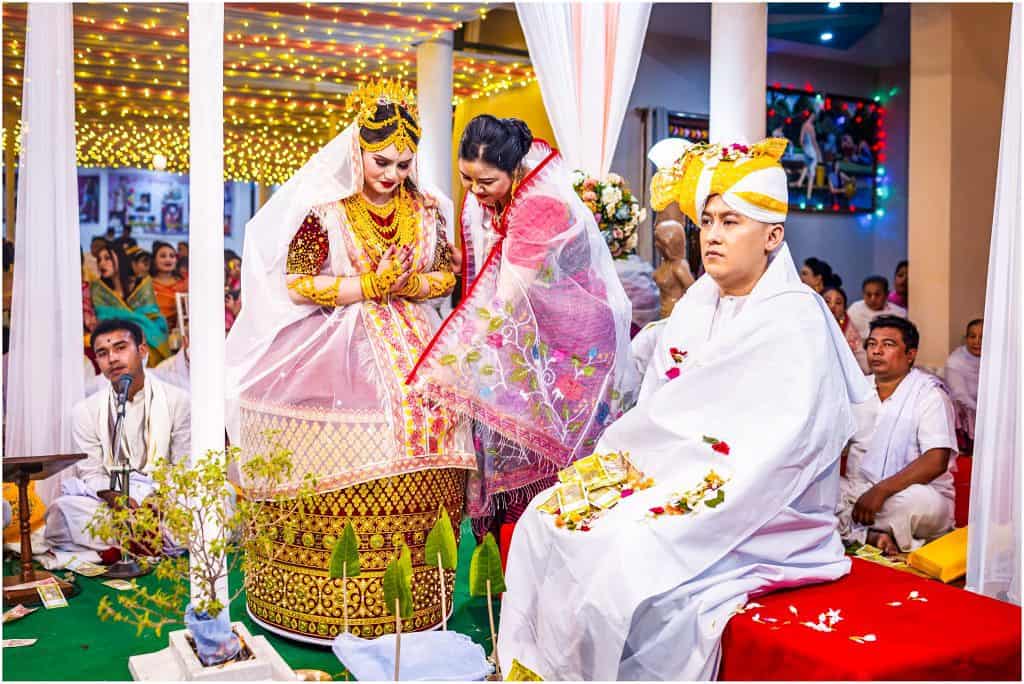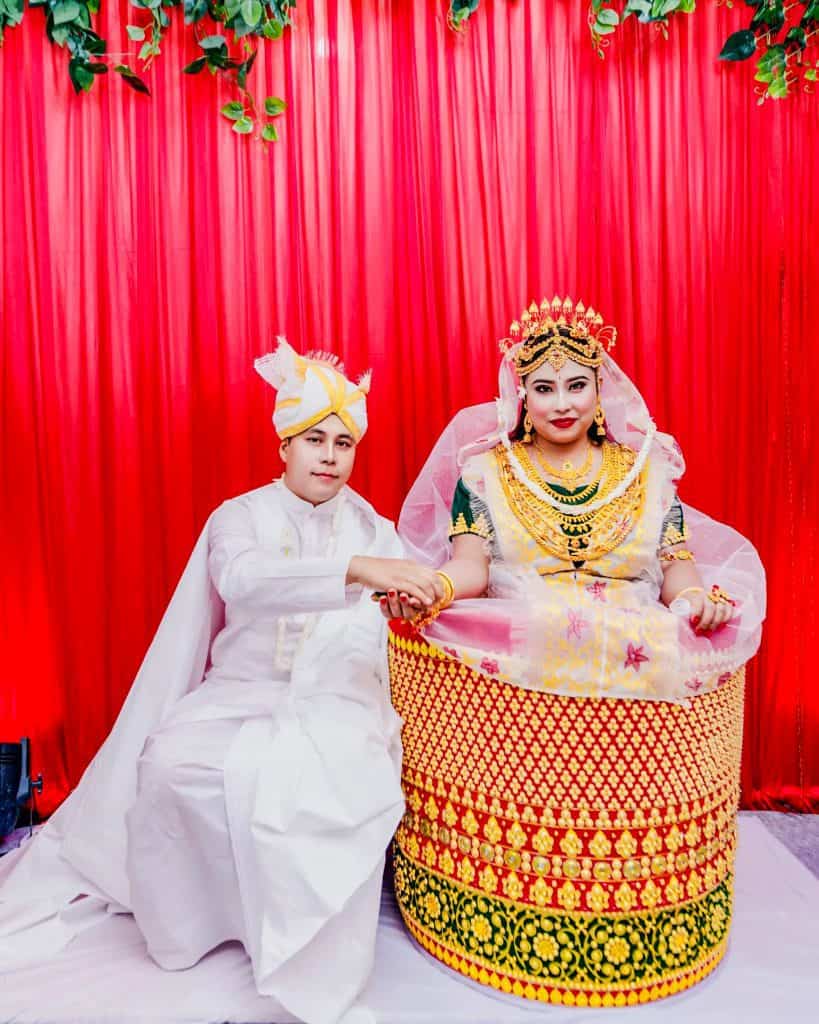Traditional Manipur weddings, a vibrant blend of cultural richness and traditions, uniquely intertwine rituals, attire, and festivities, reflecting the profound essence of Manipuri heritage.

Manipur, tucked away in Northeast India, is a region that celebrates weddings with a unique cultural identity, keeping alive traditions, and contemporary mores. These celebrations are lively and colourful, showcasing the region’s traditions through a series of rituals before and after the wedding.
In Manipur, people usually marry within their community, but marriages outside the community are also accepted. The process of finding a spouse often starts with the potential bride and groom meeting. A popular time for young men and women to meet potential life partners is at the grand New Year Festival, offering a perfect setting to find someone special.
In Manipur wedding traditions, weddings are viewed as sacred moments where two individuals come together to enrich each other’s existence with joy and vibrancy. The term “luhongba,” used by the Manipuri or Meitei community, refers to marriage, symbolizing the deep connection and unity of heart between a man and a woman.

The Meitei community remains faithful to their ancestral customs, untouched by Western or contemporary influences. This adherence enhances the beauty of their culture and showcases its unadulterated essence.
Pre-wedding Rituals
Manipur weddings are of two types: elopements and arranged marriages. They mostly have the same rituals, but the beginnings are a bit different.
In an elopement, three, five, or seven men from the groom’s family go to the bride’s family to let them know their son has chosen their daughter. After telling the bride’s family, the bride is brought to the groom’s house. Later, she goes out with the older women of the groom’s family.
The main difference between an elopement and an arranged marriage is how the bride and groom come together. In an elopement, the bride and groom choose each other. In an arranged marriage, families do the planning as usual.
The groom’s family visits the bride’s family three times until they agree on a wedding date. Both families also decide what gifts to give to the Pala, the woman who sings religious songs at the wedding.
Let’s explore more pre-wedding ceremonies of Manipur
Hinaba
Hinaba is the first step in a traditional or arranged Meitei wedding. It’s when the bride’s and groom’s parents meet for the first time. During this meeting, they compare the bride’s and groom’s horoscopes to set a wedding date. After everything is agreed upon, the families decide to meet again later.
Yathang Thanaga & Waraipot Puba
During the Yathang Thanaga, the bride’s family, usually her parents, go to the groom’s house to officially say yes to the wedding. After that, the Waraipot Puba happens when the groom’s family visits the bride’s family to return the respect and happiness. Both of these events usually involve sharing food and gifts.

Hejiapot
The Hejiapot ceremony is like the official engagement in Meitei culture. In this event, the groom’s family brings food, gifts, fruits, jewellery, and clothes to the bride’s house, along with the rings for both the bride and groom. However, unlike typical engagements, the bride and groom don’t meet each other before the wedding day. Only the families’ elders take part in the Hejiapot celebration.
Once the ceremony is done, a priest sets the wedding date. The groom’s family then leaves, and in the evening, the Hejiapot turns into a celebration where the bride enjoys a party with her family and friends.
Wedding Customs
Following the pre-wedding ceremonies and the setting of the wedding date, the traditional Manipur wedding then begins with much joy and celebration. Let’s explore further the traditional wedding rituals of Manipur Wedding:
Bor Baton & Leilenga
This part is about inviting the groom to the traditional weddings of Manipur. The bride’s brother does this by giving the groom a special garland called Pana Kwa, made from betel leaves, betel nuts, and banana leaves, all tied together with a white cloth. This happens at the groom’s house. At the same time, at the bride’s house, there’s a different ceremony called Leilenga.
Here, the bride makes two flower garlands – one for herself and one for the groom, with the help of a priest who says prayers for a happy marriage. The flowers used are called Kundo. After making these garlands, the bride has her last lunch at home with her parents.
Luhongba (wedding Day)
Traditional Weddings of Manipur are held at the bride’s home. The ceremony starts when the groom and his relatives arrive and are welcomed by three elder women from the bride’s side. They receive a welcome of betel leaves and betel nuts presented on a banana leaf.
The special area for the wedding called the mandap, is set up around a tulsi (holy basil) plant, and the entire ceremony revolves around this plant. The groom first sits with the priest for prayers, and then the bride joins later.
During the ceremony, the bride and groom hold hands, and the bride’s mother ties their hands together with a thread as a blessing. She then blesses them with a plate containing a coconut, banana, and betel leaves and nuts. After this, other family elders bless the couple and may also give them money. The bride walks around the groom seven times, and then they exchange garlands.
Post-Wedding Traditions in Manipur
Phamnando: The bride brings a single and a double bed to her new home with her in-laws. Her uncle touches the single bed, wishing her a joyful and fruitful life. She then sits on the bed while the elders bless her.
Mangani Chakouba/Chaoba: This traditional wedding reception happens 5 days after the wedding at the bride’s family home. It’s a feast to celebrate the new union.
Wedding attire for the bride at a Traditional Manipur
For her wedding, the bride dresses in a traditional “Rasleela outfit”, reflecting the deep devotion to Radha and Krishna shared by many. The “Potloi”, a drum-shaped bridal dress notable for its religious embroidery crafted by skilled artisans, carries great cultural significance. In modern times, many brides choose to rent the “Potloi” and accompanying jewellery, though some opt to create their own sets.
The Potloi is a striking cylindrical skirt known for its vibrant colours such as pink, green, yellow, and predominantly red. Adorned with glittering stones, studs, sequins, and lace, its intricate designs and geometric patterns make the Potloi truly spectacular. This ancient attire owes its continued appeal to its detailed applique work and timeless elegance. Paired with a blouse and the Innaphi, which is elegantly secured at the waist with a belt, the ensemble creates a breathtaking bridal look, complemented by simple jewellery and a graceful headband.
The Innaphi, akin to a shawl, is draped over the upper body, adding a layer of sophistication. While not originally from Manipur, it has become an essential part of the bride’s outfit. Traditionally crafted in soft pastel shades using semi-transparent fabric, the Innaphi requires skilled craftsmanship to achieve its regal appearance. Though usually devoid of stone or stud embellishments, custom designs can incorporate these for added opulence. The emphasis on thread embroidery and subtle hues ensures the Innaphi retains its classic appeal, even as modern variants like the Rani Phi introduce silk threads and contemporary colours for those seeking a distinct look.
The Phanek, similar to a sarong or wrap-around skirt, differs from its counterparts by using opaque fabrics like cotton, silk, or synthetics, making it suitable for the lower body. Handwoven with simple yet elegant designs, Phaneks typically feature block colours or stripes and avoid flamboyant patterns, with traditional motifs like the lotus and bee being particularly revered. When paired with a blouse, the Phanek elevates to an ensemble akin to the North Indian saree, achieving an ethnic flair that is beautifully accentuated by jewellery.
Together, these pieces create a bridal look that is both deeply rooted in tradition and adaptable to modern tastes, ensuring that the bride stands out on her special day with a blend of elegance, culture, and personal style.
The bride’s ensemble includes a long necklace called “Likhom”, and she also wears two sets of “Merei”, which are essential to her attire. Additionally, a traditional headgear is a must for the brides.
Wedding attire for the groom at Traditional Weddings of Manipur
The groom’s attire is more understated, consisting of a simple dhoti and kurta, complemented by a turban and a plain white shawl, symbolizing purity and calmness.
In a traditional wedding, the groom’s attire is a study in elegance and simplicity. The centrepiece of this ensemble is the Kurta, a long coat-like garment that extends to the knees, traditionally paired with a dhoti. Cotton is the preferred fabric for its comfort and breathability, available in a spectrum from vibrant hues to subtle pastels. While modern kurtas feature elaborate embroidery and threadwork, the traditional Manipuri groom opts for a white kurta with full sleeves, emphasizing purity and simplicity.
Complementing the kurta and dhoti is the turban, a significant piece of attire in Indian weddings, symbolizing respect and honour. In Manipur, the groom’s turban is typically white, mirroring the kurta’s simplicity but can be adorned for a touch of personal flair.
A plain-white shawl draped over the shoulders completes the groom’s attire, adding layer of dignity to the overall look. This straightforward yet sophisticated outfit not only showcases the enduring appeal of traditional wear but also pays homage to the cultural heritage of the Manipuri people. The groom’s attire, though understated, represents the beauty and grace of Indian customs, proving that sometimes, simplicity is the ultimate sophistication.
The Manipuri wedding blesses couples with a life of happiness and prosperity
The Manipuri wedding, with its array of rich traditions and rituals, beautifully encapsulates the cultural heritage of Manipur. From the cleansing Nat Sankirtana, where sacred fires burn and hymns fill the air, to the symbolic release of fishes in the Meetam-Nga-Thaba ceremony for good luck, each ritual is steeped in meaning. The bride’s ceremonial walk around the groom during Lei-Koiba, the exchange of garlands, and the shared sweetness of Kangsubi signify the couple’s love and mutual respect.
Post-wedding traditions like Phamnando and the Mangani Chakouba/Chaoba feast further celebrate the union, embracing the couple into the community and ensuring a life of happiness and prosperity. These ceremonies passed down through generations honour the past and also weave a rich tapestry of love and communal unity, showcasing the beauty and depth of Manipuri culture. Experiencing a Manipuri wedding is to witness the heart and soul of its people, a celebration of life, love, and cultural legacy that is truly unforgettable.
The wedding traditions in Manipur are truly magical. From the betel leaf and betel nut to the Potloi dress, every part of a Manipur wedding is designed to amaze and delight you. These traditions showcase the rich culture of Manipur and its people.
Read more: Latest



